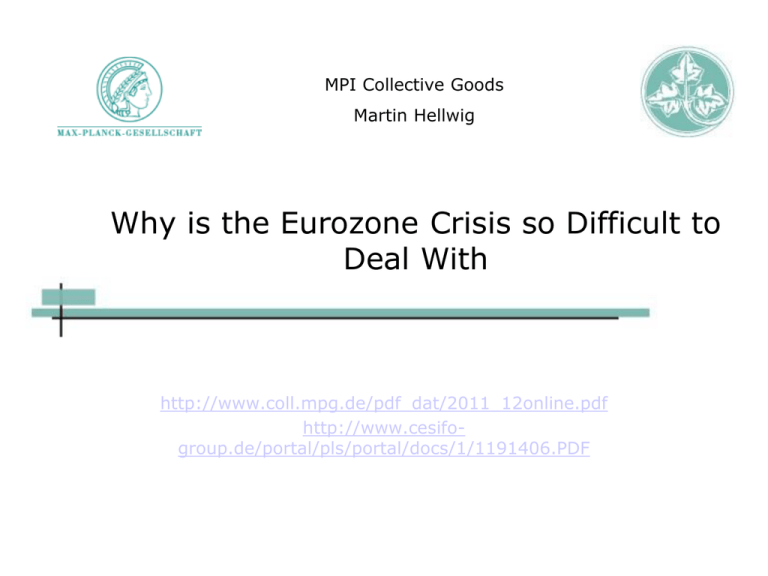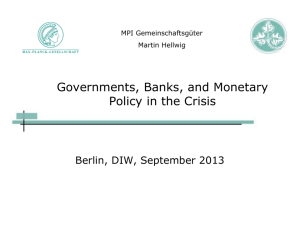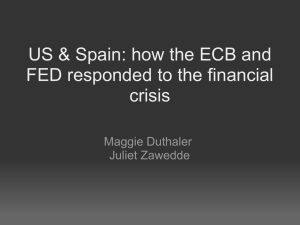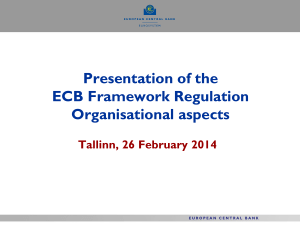Managerial Report
advertisement

MPI Collective Goods Martin Hellwig Why is the Eurozone Crisis so Difficult to Deal With http://www.coll.mpg.de/pdf_dat/2011_12online.pdf http://www.cesifogroup.de/portal/pls/portal/docs/1/1191406.PDF Introductory Remarks European integration has always involved a strange mixture of idealism and pursuit of national interest with a lot of log rolling Example: The Schuman Plan 1950 (Coal and Steel Community): Co-operation as a basis for trust De-nationalization of control over the (German) war industries (coal and steel) Re-integration of Germany into the international community The quintessential bumble bee. The „Euro Crisis“ Not a currency crisis! A sovereign debt crisis of the usual type in Greece, Portugal, and perhaps Italy A banking crisis, due to a real-estate boom and bust, in Ireland and Spain, … inducing a sovereign debt crisis in Ireland and perhaps also Spain A latent banking crisis in Germany and France where banks have relatively little equity and a lot of involvement with GPIIS Spring 2010: Why were the rules broken? The Treaty has a no-bailout clause Why was it not applied? The European Commission did not want to By not applying the rules they could increase their own turf France did not want to: French banks were strongly exposed to Greece Germany? … gave in to pressure from France To save German banks without appearing to do so? Because Greece had only a „liquidity“ problem? Why is there no long-run strategy? March 2010: guarantees for 110 bn. EUR Greek debt May 2010: creation of EFSF with funds of 60 bn. from EU, 440 bn. from member states, 250 bn. from IMF May 2010: beginning of SMP October 2010: Merkel/Sarkozy: Future Bailins November 2010: Finance Ministers: Bailins only in Solvency Crises Ireland (November), Portugal (April 2011) March 2011: Agreement on ESM (=permanent EFSF), July 21, 2011: New Package for Greece, new competence for EFSF/ESM additional leverage; PSI Why is there no long-run strategy? August 2011: Barroso: Package is not enough ... Stock market declines… doubts about banks … Withdrawal of short-term $ funding (MMFs)... „Runs“ (?) on Italian and Spanish government debt October 2011: Summit „Six Pack“, including call for repitalization on banks by June 30, 2012 .... November 2011: Recapitalization requirement fixed as a ratio requirement..... Deleveraging December 2011/January 2012: ECB‘s LTRO launched ... banks buy sovereign debt.... February/March 2012: New Greek rescue package with significant PSI; Fiscal Pact concluded Why is there no long-run strategy? Multiplicity of conflict lines Commission – Member States Borrowers – Lenders France – Germany (personalities, interests) Governments – Banks ECB - Governments Delay as a strategy „Guarantees do not cost anything“ (cameralistic accounting at the German finance ministry) Intransparency as a means of hiding costs Difficulty of the Problem Institutional Framework European Union: Commission, Council, Parliament jointly have legislative power under the Treaty The Commission has (limited) executive power Monetary Union: European Central Bank is independent Fiscal Policy: National competence … subject to the stability and growth pact … and the no-bailout clause of the Treaty ... and in the future the new fiscal pact (! !) Difficulty of the Problem Large haircuts on sovereign debt or interbank debt … would endanger or destroy banking systems … could lead to a huge write-off at ECB … would not re-establish competitiveness in international markets In the Greek case, many of the losses have been socialized – Greek banks are encompassed in the rescue package Difficulty of the Problem A re-introduction of the drachma would do the job, but then how would the Greek government finance its primary deficit? And how would Greece cope with the twin run on banks and currency? Constellations in other countries are similar, with a strong concentration of holdings of sovereign debt in the country‘s own banks, … but with Spain or Italy, there would be substantial second-round effects from interconnectedness of banking systems Role of the ECB Inaction of fiscal authorities has left the ECB as the only institution in a position to act quickly Like the Fed, ECB has expanded its balance sheet through lending on collateral and buying It holds large amounts of sovereign debt and bank debt, directly and a scollateral LTRO programs have accelerated the process Addresses liquidity problems... Solvency?? Target 2 positions? Role of the ECB Expansion of ECB balance sheet has not been very inflationary Even so, losses taken on ECB losses are costs to the taxpayer (waste of seigniorage) But, in a constellation with system-wide excessive leverage, this may be the cheapest way to neutralize the fallout … if it were not for the implication that politicians are finding out that banking problems provide access to the printing press Role of the ECB Losses from haircuts do not pose a problem for the ECB as a business unit, but they do pose a political problem, … need to „recapitalize“ … focuses discussion on the role of the ECB as a component of the mechanism of fiscal redistribution … gives room for discussion about governance of central banking in EMU Why did things go wrong in the first place? Creation of EMU led to a disappearance of spreads (relative to Germany): from close to 14 % in 1995 for Italy, close to 10 % in 1998 for Greece to close to zero by 2001. With less than fully integrated goods markets, price movements diverged, leading to differences in real rates of interest across countries: Ireland/Spain versus Germany/Netherlands Overvaluation of DM relative to other countries at entry into EUR Why did things go wrong in the first place? Elimination of exchange rate risk fuelled capital movements from north to south + Ireland Role of differences in real rates: Ireland, Spain (building booms) Role of demography (Germany) + export orientation Role of low rates on public sector borrowing (Greece, Italy, … Germany (!)) High growth in Ireland, Spain, Greece, low growth in Germany Why did things go wrong in the first place? Risk premia began to rise when the subprime crisis broke. The new (?) crisis broke out when in the fall of 2009 the new Greek government declared that the numbers had been cooked and government deficit was 13 % rather than 6 – 8 % of GDP (in fact 15 %) In 2010, this was followed by the burst of the real estate bubbles in Ireland and Spain A puzzle Why did risk premia remain close to zero until 2007? Von Hagen et al. (2004) already raise this question … didn‘t banks understand that governments no longer had the ability to print what they owed? … or did they expect that institutions would be changed to bail them out? Risk Weights and Leverage Zero risk weights on government debt (still in force) Low risk weights on real-estate and interbank lending With a given amount of equity you can invest arbitrary amounts in government debt if you can find funding: Dexia (F) has equity equal to .67 % of total assets. Hypo Real Estate had around 1 %. … the analogues of Fannie and Freddie … and the authorities? … are thinking of „their“ banks as national champions with whose successes they must not interfere … laxity in Ireland and Spain … and in Germany… … are thinking of banks as a source of funds rather than a source of risks... Which is why zero risk weights are wonderful! A Comment on German Banks 1 German banking has severe structural problems Four segments: private, co-operative, publicretail, public-wholesale (Landesbanken) Retail is profitable for public savings and cooperative banks. Wholesale profitability has been squeezed since the mid-nineties: Landesbanken have no viable business model Private Banks are in danger of losing theirs A Comment on German Banks 2 Landesbanken have forever been gambling for survival one major scandal per decade Probably a 300 bn. involvement in subprime Large investments in Southern Europe Private Banks have taken very long to understand the structural change Dresdner went under (acquisition by Commerzbank) HVB spun off Hypo Real Estate in order to be taken over by Unicredit HRE saved and maintained (!) by Government Commerzbank saved by the Government A Comment on German Banks 3 Lack of an exit mechanism for the Landesbanken – political economy Destabilization of real-estate/covered-bond finance system … even when they need federal money Intransparency about bailouts as a consistent strategy… Bad banks for West LB and HRE will take time to do their accounts Total expected taxpayer losses from crisis at this point 80 – 100 bn. EUR A Comment on German Banks 4 Difficulties of recapitalization of public banks ….. have shaped the German (and French) negotiating position in Basel ….. and now The notion of the bank as a source of (cheap!) funds for public purposes drives political discourse about regulation and supervision… even now Europeanization of supervision may be the only way to break that link Summary 1 Interdependence of three crises, sovereign, Irish-style banking crisis, German-style banking problems is hard to disentangle Overlapping conflicts between different parties and different institutions make negotiations difficult …. and contribute to the proliferation of halbaked press announcements that is itself a source of financial system risk Summary 2 Do the major players have the political will to actually tackle the crisis? Are they willing even to identify what the problems are (solvency vs. liquidity, banking problems, governance, time.consistency) Are they able to so? (dominance of legalistic thinking, cameralistic accounting)











